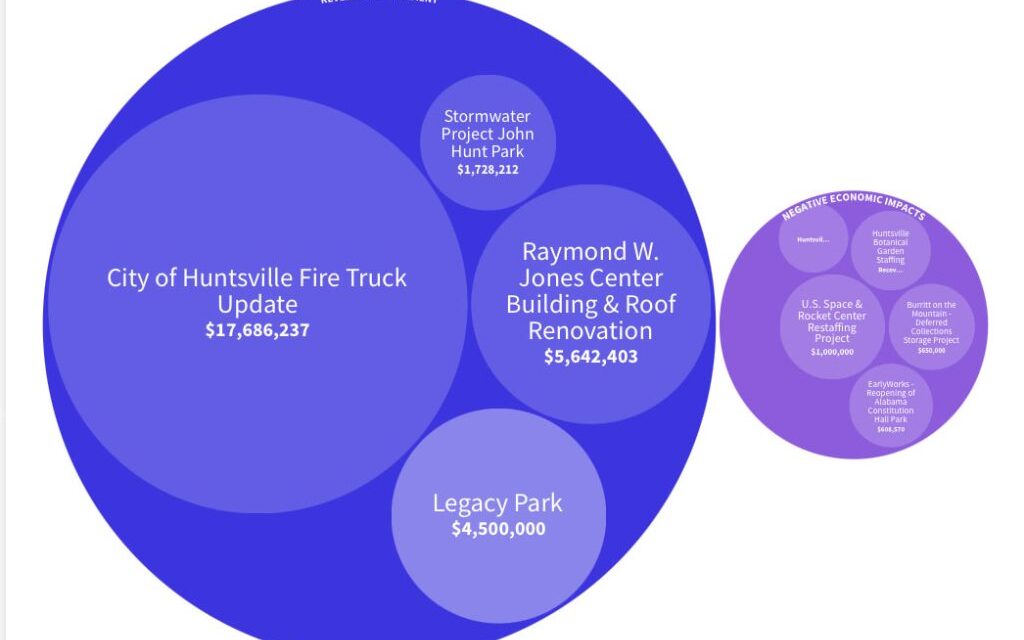By Speakin’ Out News
Huntsville, Alabama, recently made headlines with its strategic investment of federal pandemic recovery funds to address the city’s rapid population growth and enhance community services. Faced with unprecedented growth, the city utilized approximately half of its $34 million allocation from the State and Local Fiscal Recovery Funds to bolster its firefighting capabilities and support tourism and recreational initiatives.
Investing in Safety: Upgrading the Fire Truck Fleet
Amid the COVID-19 pandemic, local governments across the United States received funds from the federal government to mitigate the economic impact and enhance community resilience. Huntsville allocated nearly $18 million of its recovery funds to purchase 21 new fire trucks, including ladder trucks, pumper trucks, and a hazardous materials truck.
“It’s hard to measure the impacts of adding or updating a fire truck fleet, but just having those 21 extra fire trucks is just an invaluable asset to our community,” said Penny Smith, the city’s finance director.
Responding to Population Growth
Huntsville’s population has been on a steady rise, now recognized as the most populous city in Alabama. As of September, the planning department reported that approximately 235,000 people reside in the Rocket City, a significant increase from the 215,000 recorded in 2021. This 3.3 percent increase over the previous year marks the highest single-year growth rate in a decade.
The city’s administration and council prioritized the health and safety of its residents alongside economic recovery. “Administration and city council were on the same page as far as what would best serve the citizens, and what would best serve our economy as we were rebuilding during COVID,” Smith said. “And that was to focus on the citizens’ health, but then also the health of the city in terms of revenue dollars.”
Enhancing Tourism and Recreation
In addition to bolstering emergency services, Huntsville directed the remaining half of its pandemic recovery funds towards enhancing tourism and recreational facilities. The Alabama Constitution Hall Park received funds to rehire employees and support educational programming and admission assistance for student field trips. The U.S. Space & Rocket Center was awarded $1 million to support restaffing and STEM education programs.
One of the significant recreational projects funded was the development of Legacy Park, located on the former J.O. Johnson High School property. The park, which opened in June 2023, features a large playground, walking loop, green spaces, and areas available for rental.
Planning for the Future
As of September 2023, Huntsville had allocated projects for all but $2 million of its recovery funds. Penny Smith assured that any remaining funds would be directed toward initiatives already approved by the Huntsville City Council. The funds from the American Rescue Plan Act, enacted in March 2021, are required to be designated for specific projects by the end of 2024 and spent by the end of 2026.
Detailed Breakdown of Huntsville’s Pandemic Recovery Projects
Huntsville’s allocation of its State and Local Fiscal Recovery Funds demonstrates a balanced approach to enhancing public safety and supporting economic recovery through strategic investments in essential services and community amenities. Here’s a detailed look at the city’s pandemic recovery projects:
- Firefighting Capabilities: $18 million for 21 new fire trucks, including ladder trucks, pumper trucks, and a hazardous materials truck.
- Tourism Workforce Maintenance: Funds for rehiring employees and supporting educational programs at the Alabama Constitution Hall Park.
- U.S. Space & Rocket Center: $1 million for restaffing and STEM programs.
- Legacy Park Development: $4.5 million for the new park, featuring playgrounds, walking loops, and rentable green spaces.
As Huntsville continues to grow, these investments are expected to play a crucial role in maintaining the city’s quality of life and economic vitality, ensuring that the community is well-equipped to handle future challenges











